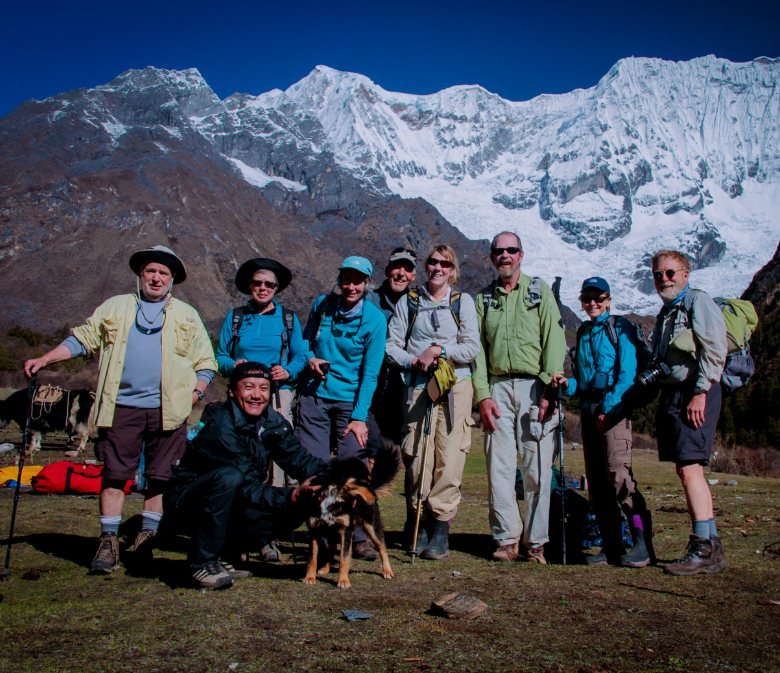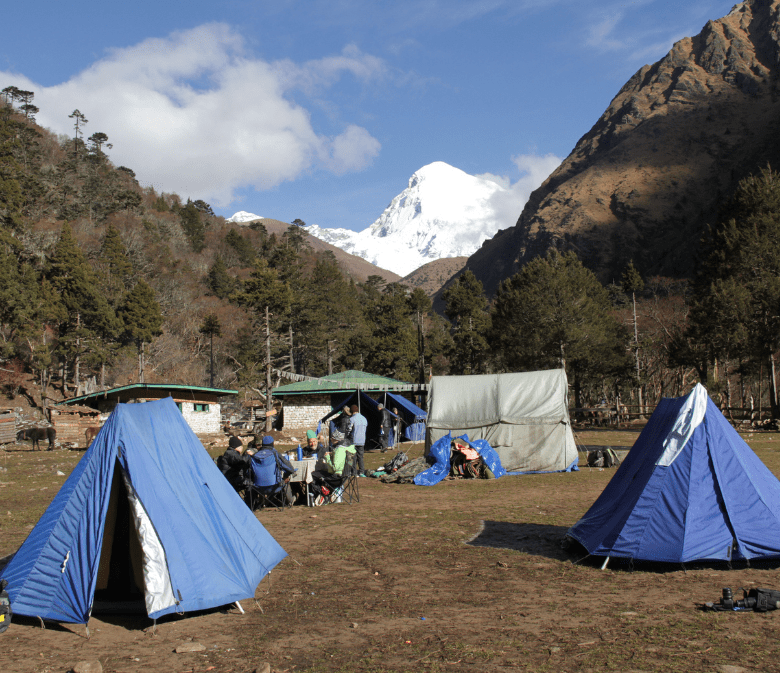- Overview
- Trip Outline
- Trip Includes
- Trip Excludes
- Gallery
- Booking
- FAQ
A trek to Jomolhari is an opportunity to experience the wild life and rare plants in the western Bhutanese region. The hike passes through Jangothang, Paro and base of Mt. Jomolhari. This Trek route is a very popular and passes through some of the beautiful high passes and the Yak Herders’ camp. The Trekkers can see some of the most spectacular sceneries of the Higher Himalayas including Jichu Drake. You will also have the opportunity to see Blue sheep and other wild life in these areas.
Jomolhari Trek is one of the most popular treks in Bhutan. With altitude differences of 2,500m and nearly 5,000m (lowest and highest point of the route) it offers a wide range of landscape and fauna and flora. The highlight of this trek is the spectacular view of Mount Jomolhari from Jomolhari Basecamp in Jangothang.
Itineraries
Day 1
Fly in Paro, Bhutan - Paro
Welcome to Bhutan. On a clear day, one will experience breathtaking views of major Himalayan peaks, Jomolhari and Jichu Darkey in Bhutan from your flight. Upon arrival Bhutan's first gift to you will be clean fresh mountain air. Obtain your Bhutan visa which will be pre-paid, and after clearing Immigration and Customs, you will be met outside at the exit point by Bhutan Sky Trails representatives and escort you around for the sightseeing, onward to your hotel.
Visit Ta Dzong (National Museum), which towers above the Paro Dzong and viewing its well-interpreted collection of historic artifacts that makes a great prologue to the journey yet to come.
Visit Paro Dzong. This massive fortress is located in the Paro valley and is approached by a gently sloping flagstone road and a beautiful wooden bridge roofed with shingles and abutted by two guardhouses. Today, the Dzong is the Administrative seat of the district of Paro and it also contains a state monastic community of about 200 monks. The central tower ("Utse") of the Dzong is one of the most beautiful in Bhutan with its superb woodwork. The Dzong was built in 1646 A.D.
Day 2
Paro – Shana Zampa (Campsite elevation 2890m)
Hike to Taktsang (Tiger’s Nest) Monastery. The Icon monastery of Bhutan, this monastery clings to a cliff which was built in 17th century. The monastery was burnt in 1998 and was rebuilt. The mountainside viewpoint for this dramatically situated and most sacred site is accessible by walk of about 5 hours round trip. There is also a cafeteria at mid-point, where one can enjoy refreshments and meals.
After your return to the base of Taktsang from the hike drive to the north of the valley passing by Drugyel Dzong and beautiful villages around. You will meet with your trekking team for your adventure that waits ahead.
Day 3
Sharna Zampa- Thangthangkha
Approx: 22km, 7 - 8 hours, 770m ascent, 10m descent, camp altitude 3,610m.
On this long day, the trail continues with lots of small ups and downs. After going uphill through the river valley, you enter the Jigme Dorji National Park. The valley finally narrows gradually to a mere path which descends to a meadow where a camp will be set up. From here, if weather permits, you will have the first great view of Mount Jomolhari.
Day 4
Thangthangkha - Jangothang
Approx: 19km, 5 - 6 hours, 480m ascent, camp altitude 4,080m.
If you did not see Mount Jomolhari last evening, you will have a great chance to get a great view this early morning. This morning the trek continues up the Paro Chhu valley which widens into patches of alpine meadow and scanty growths of forest. Cross an army outpost along the way and enjoy a spectacular view of high mountain ridges and snow-capped peaks. Yaks and the herder’s homes become a regular feature of the landscape. Passing the villages Soe, Takethang and Dangochang is another asset on this day. Reaching Jangothang, one of the most beautiful campsites of the Himalayas, you will again have a spectacular view of Mount Jomolhari.
Day 5
Halt. (Acclimatization Day)
The day in Jangothang provides plenty of possibilities for day hikes with great views on lakes and snow capped mountains such as Jomolhari and Jichu Drake. There are good chances to spot some blue sheep on the upper slopes of the valley. Jangothang is a perfect environment for your acclimatization. Trek up to Tosoh or hike around the area. There are good short hiking trails in three directions. Jumolhari and its subsidiary mountain chains that lie directly west, Jichu Drake to the north and a number of unclimbed peaks to the east.
Day 6
Jangothang - Dhumzo
Approx: 16km, 6 - 7 hours, 810m ascent, 1,090m descent, camp altitude 3,800m)
The trail leads to a last settlement in the valley and drops to the Paro Chhu. Passing the lake of Tshophu (4,380m) you will climb up steeply to Bhonte La pass at 4,890 m, the highest point of this trek route. Reaching the DhumzoChhu river, you trek downstream passing the few houses of Dhumzo to arrive at your camp soon after.
Day 7
Dhumzo - Thombu Shong
Approx: 11km, 4 - 5 hours, 720m ascent, 340m descent, camp altitude 4,180m.
The trail climbs through birch, rhododendrons draped in Moses lead to a ridge to drop to another stream. After crossing the Takhung La pass (4,520m) you descent to Thombu Shong, three yak herder huts with your campsite next to them.
Day 8
ThombuShong - Gunitsawa - Thimphu
Approx: 13km, 4 - 5 hours, 200m ascent, 1,650m descent,
Climb out of the valley to Thombu La pass (4,380m), then the trail descends gradually and makes a steep switch back descent down the ridge before you will finally reach Gunitsawa, where you will bid farewell to the trekking team and meet your transport to drive to Thimphu.
Day 9
Thimphu – Thimphu
Begin the day with the visit the Memorial Chorten built in 1974, in memory of the third King of Bhutan who reigned the country from 1952-1972. Next visit the Buddha Dordema located at Kuenselphodrang, it is 51.5 meter bronze statue overlooking the Thimphu valley. After that stop by Changangkha temple built in 12 century; Visit the Painting School (ZorigChusum if in session) where traditional art and craft is still kept alive, Takin preserve to see Bhutan’s national animal. Visit Zilukha nunnery to grasp the role of woman in Bhutan’s spiritual realm. Visit the Handicrafts Emporium where Bhutanese textiles and other arts and crafts are displayed which can be purchased. Visit TashichhoDzong, the main secretariat building. This massive fortress houses part of the government Ministries, the office of the King and the Throne Room. It also houses the State Monastic Body, the office and the living quarters of the Chief Abbot.
Day 10
Thimphu – Punakha
Embark approximately 2 hours 30 minute drive to Punakha over Dochula Pass (3,150 m) to a beautiful glacier valley of Phobjikha. Stop at the Dochula pass for hot cup of tea/coffee, chance to stretch your legs and use proper toilet facilities. On a clear day one can view the Himalayan ranges with 108 stupas named as “Druk Wangyel Chorten” that have been erected here by the Queen Mother.
From Dochula pass take a gentle and beautiful hike through the forest of hemlock and rhododendrons to Lungchutse Temple, located at the elevation of 3,569 meters. This hike has lots to offer to you and most importantly 360 degree view of Himalayan ranges on a clear day. Photos do not justify the beauty of the place as seen through the lens of the living eyes. Then you will drive to Punakha and once you get to Punakha valley, from the village of Sobsokha take a short walk through the rice pounding village to take a short walk to visit Chimi Lhakhang, a fertility shrine, built in the 15th century by Lama Drukpa Kuenley, also known as the “the Divine Madman”. The cheerful flying phallus that one sees painted on homes throughout Bhutan is a tribute to this saint, whose presence distracts and thus repels evil spirits.
Day 11
Punakha - Punakha
This morning drive to the north of the valley around 30mins and take a hike, which is around 1 hour to Khamsum Yule Namgyel chorten, which took more than 9 years to complete it. The walk through rice fields, passing by farm houses is very scenic and beautiful.
Visit the Punakha Dzong, which house the district administration offices. It is also the winter residence of the central monastic body and the Je Khenpo head monk of Bhutan. The dzong was damaged by fire in 1986, and recently renovated using traditional building techniques. It is one of the most beautiful Dzong in the country, located at the confluence of Pho chu (male river) and Mo chu (female river).
Day 12
Punakha - Paro
Drive approximately 4 hours’ drive to Paro stopping in Thimphu for any last minute shopping. Visit Bhutan Post to make your personalize stamp if you wish or visit the local market, this is a wonderful opportunity to witness daily life of people. If locals are practicing or playing archery (the national sport) you can stop and witness the sport. Visit traditional paper making unit and on the way to Paro stop by Tachogang to see the 15th century Iron chain bridge, and after reaching Paro explore Paro town.
Day 13
Depart.
After breakfast, say good bye to this lovely country and you will then be transferred to the airport for you flight.
No Details Found




